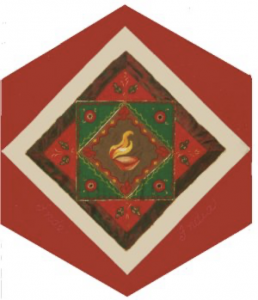India

The Block
Indian textiles are as diverse as its culture. In this block, the result of collaboration between Shilpa Mehta, Delores Chew and Reina Cross, a selection of layered materials symbolize India’s multifaceted society. A variety of techniques provide but a small sample of the richly-textured needlework for which India is so well known. Fine cotton is superimposed on Shishadar embellished cotton, which in turn is stitched onto a piece of finely woven silk.
Each piece of fabric was cut from a piece of clothing – the silk, taken from a sari (the traditional costume of Hindu women), and the cottons from dresses. Both the designs and styles of needlework (gold-work, smooth and wire purl work, couching, colourful surface embroidery, and Shishadar) are characteristic of the lavishly decorated garments worn by the people of India.
Shishadar, or mirror work, is a process in which buttonhole stitches surround small pieces of silvered glass or mica securing them to the fabric. The clay oil lamp depicted at the centre of the piece is typical of those found in most Indian homes. Oil lamps, primarily a source of light, are also used as important ritual accessories.
Cultural Profile
India, the cradle of one of the world’s first civilizations, was for millions of years a separate continent. The force of its geological collision with Asia created the Himalayas, the world’s youngest and highest mountains. India has an ancient tradition of education, which includes the establishment of the world’s first university (in 700 B.C.), the introduction of the ‘zero,’ the decimal system and multiplication. The country is also the site of the famous Taj Mahal (thought by many to be the world’s most beautiful building), which took more than 20,000 workers 22 years to complete.
India’s ethnic composition is complex, but two of the major groups are the northern Aryan and the southern Dravidian. Although English is the language of commerce and politics, Hindi is the national language and primary tongue of one-third of the population. In addition, there are 14 other official languages (including Bengali, Telugu and Urdu) and more than 1,500 regional languages and dialects.
Social life in India is generally centred on the family and gender distinctions are quite pronounced, as the behaviour expected of men and women is very different. Dances, which tell stories through mime, drama and music, are an important part of the culture and children are taught the meaning of their traditions through the practice of centuries-old songs and movements. A more modern version of India’s song and dance are the Bollywood films, featuring colourful costumes and elaborate dances. They have helped make the diverse Indian cinema industry the most lucrative in the world. Classical Indian music often features the sitar and veena (long-necked stringed instruments), and the tabla (a percussion instrument). The folk music traditions of India are very rich, as is the variety in musical instruments, due to the ethnic and religious diversity of the country.
Festivals also play a big part in Indian life, and with the enormous range of religious and cultural diversity, it is said that there are more festivals in the whole country than there are days in the year. Holi is the festival of colour and love, where those who venture out in public are splashed with coloured powder or water to celebrate the arrival of spring and the victory of good over evil. This festival is not only celebrated in India, but in many places around the world by people of Indian origins. Diwali, the festival of lights, is celebrated in the fall. People put on their best clothes, light candles in and out of their house, share a prayer, sweets and presents, and watch fireworks.
Each region of the country has its own handicrafts and traditional styles, including terracotta water pots and clay pipes, woodwork, jute products, jewelry, paintings and vividly embroidered Kashmir shawls. India is famous for its textiles––rich in tradition and vibrant in colour––in particular the cotton and silk weaving visible in women’s traditional saris. The area of Pochampally, for example, is known for its ikat woven saris. Ikat is a technique where threads of silk are tied and dyed individually, before being woven. Embroidery is also done in a mind-dazzling variety of techniques, materials and designs. Indian embroidery is known for its high standard of workmanship and intricate design.
The modern textile industry plays a vital role in India’s economy and is a major source of employment in the country. Fibers such as cotton, silk, jute and wool are produced and made into cloth and other products within the country and subsequently much of the finished materials are exported.
Emigrants from India have been coming to Canada since 1904, largely for social and economic reasons. Early settlers were mainly Hindu males who worked in forestry, lumber mills, mines, railroads and farming. Women and children followed in later years, but it was not until post-1951 that the Indian community in Canada grew substantially. For the most part, people from India have settled in the major cities in Ontario and Québec, and British Columbia. The 2011 census recorded 1,300,000 people of Indian ancestry living in Canada. They enjoy success in, and have contributed to, numerous areas of Canadian society, including education, politics, medicine, television and radio, and high-tech industries. They have also solidly established many community organizations designed to represent their needs. The most significant evidence of their influence on the Canadian fabric can be seen in the creation of extensive commercial districts (such as the India Bazaar in Toronto) providing the food, clothing and music for ethnic Canadian communities.
Sponsor: The Bryan family, Reina and Bill Cross
